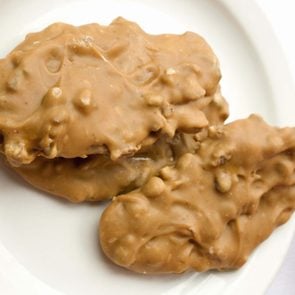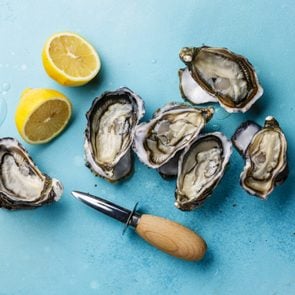What Is King Cake? The History and Meaning of the Mardi Gras Tradition
Updated: Feb. 25, 2024
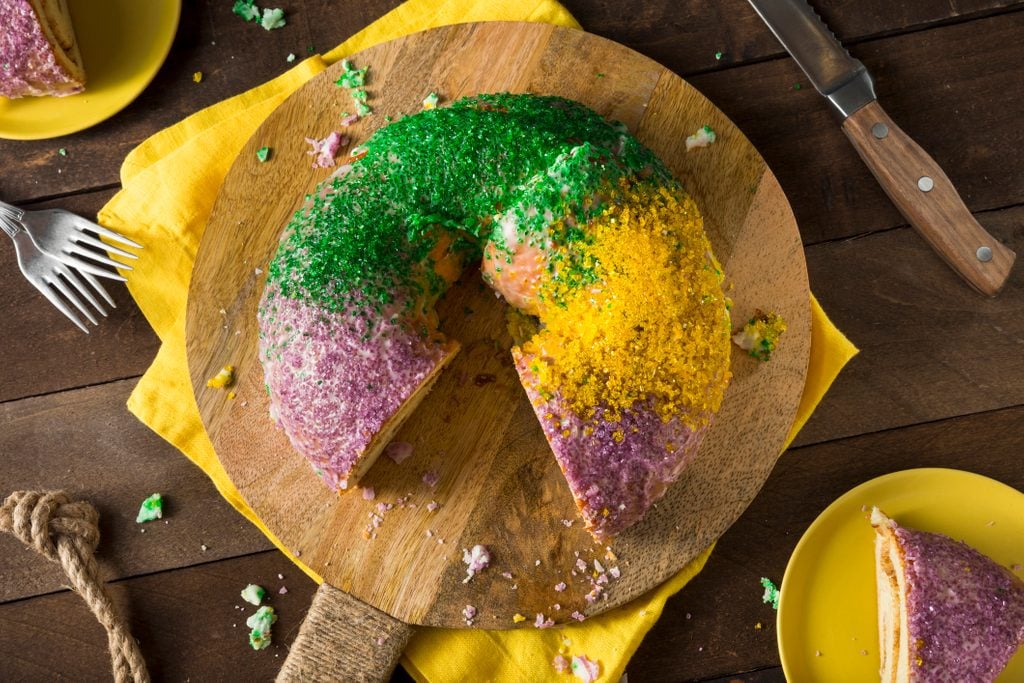
Find out what Mardi Gras king cake is all about—and what’s up with the baby hidden inside
Mardi Gras is arguably the biggest, flashiest party in the country. With its grand parades, colorful beads, elaborate masks and booze-filled revelry, you probably think you have a pretty good idea of what Mardi Gras is all about. But there are plenty of things you may not fully understand about this pre-Lenten celebration, including why Mardi Gras float riders have to wear masks.
There’s also another sweet tradition you may have heard of: eating king cake—and finding the “baby” inside of it. But what is king cake, and why is it such an integral part of Mardi Gras? Before the festive day arrives, on Feb. 13, here’s everything to know about king cake below.
Get Reader’s Digest’s Read Up newsletter for more holiday tips, fun facts, humor, cleaning, travel and tech all week long.
What is king cake?
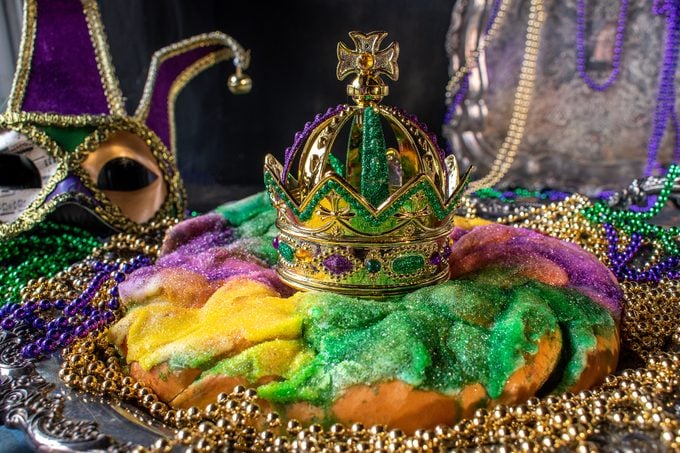
A king cake is a wreath-shaped cake similar to a Danish pastry. It’s traditionally made of brioche, flavored with cinnamon and embellished with a frosted glaze, along with gold, green and purple sugars. Collectively, these shades are the official Mardi Gras colors, and you can’t know what king cake is without knowing their specific meaning. Gold stands for power, green represents faith and purple represents justice, and overall, the cake symbolizes the unity of faiths. It also comes with a tiny plastic baby hidden inside, but we’ll get to that in a moment.
What does king cake taste like?
In New Orleans, king cake “has even become a flavor,” says Liz Williams, founder of the city’s Southern Food & Beverage Museum. If you’re wondering what king cake tastes like, during Mardi Gras, you can find everything from king cake–flavored coffee to spirits. Bakers may offer a choice of fruit or cream cheese fillings, and they sometimes top their king cakes with Mardi Gras decorations.
When do you eat king cake?
While king cake traditionally is eaten during Carnival season (from Jan. 6 through Fat Tuesday, the day before Lent begins), you can probably get your hands on one whenever you get a craving. “There are people who are baking king cakes year-round now,” says Poppy Tooker, host of the NPR-affiliated show and podcast Louisiana Eats! “In particular, in the fall, when the [New Orleans] Saints start playing, we’ll see king cakes in stores decorated in black and gold sugar.”
Why is there a baby in king cake?
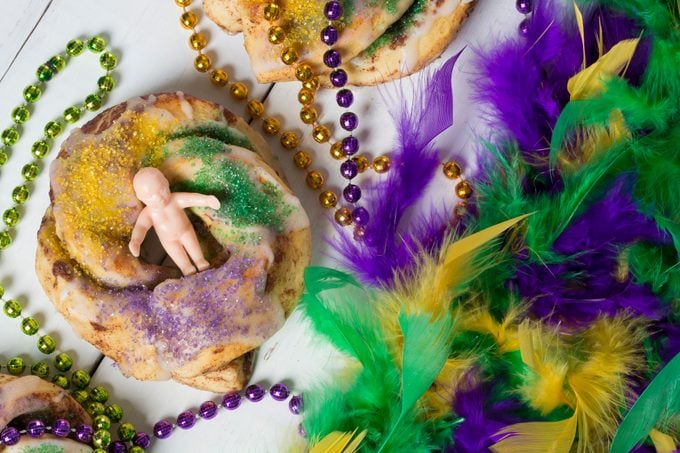
To explain this quirky tradition, let’s start with the king cake’s origins. This dessert is associated with a Catholic celebration called Epiphany, also known as Three Kings Day, which falls on Jan. 6 every year. It commemorates the story of the three wise men visiting the baby Jesus. This might lead you to believe that the baby is supposed to represent the baby Jesus, but this isn’t necessarily the case—or at least it didn’t start out that way.
According to NPR, in the late 19th century, a New Orleans social group called the Twelfth Night Revelers started the custom of hiding a bean inside the cake. Whoever found it in their piece of cake would be crowned the king or queen of the Mardi Gras balls. Later on, the bean was changed to a baby. Donald Entringer Sr., a baker who operated McKenzie’s Pastry Shoppes in Metairie, Louisiana, is credited with starting this tradition in the 1940s. Entringer was asked by a Carnival krewe to produce king cakes containing prizes. Through a friend, he came across tiny plastic babies from a shop and got approval from the health department to add them into his king cakes.
Aside from being the belle of the ball, the recipient is also said to receive good fortune after finding this prize. That person is also supposed to host the next king cake party and, of course, take care of the next king cake.
Where did king cake originate?
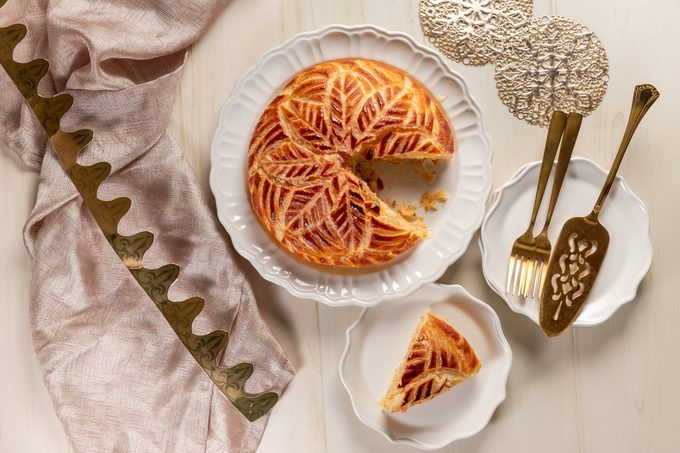
While the king cake may seem like an American tradition, its roots can actually be traced back to France, according to Adley Cormier, a historian in Lake Charles, Louisiana. When French settlers came to what is now Louisiana, they brought over their festive traditions, such as Carnival, which became Mardi Gras. “[They] brought those European traditions here and kept them up, although slightly modifying them as they had to deal with what the New World had to offer them, as opposed to what the Old World had in place,” explains Cormier.
France still has a king cake of its own, and it looks nothing like Louisiana’s rainbow-colored king cake. Known as a galette des rois, this humble and more subtly decorated puff pastry with an almond cream known as frangipane is also enjoyed by the French around the time of the Epiphany. Like its American counterpart, the galette des rois stores a surprise. It’s referred to as a fève, which translates to bean in French, but the object is usually a trinket or charm. The festivities at this time of year aren’t limited to France and America.
What is the wildest king cake ever created?
While bakeries can size up their king cakes from miniature to large, imagine a king cake that’s big enough to wrap around a building. In September 2010, Haydel’s Bakery in New Orleans accomplished that feat, creating “the world’s largest king cake” at the Louisiana Superdome. As confirmed by the good folks at the Guinness Book of World Records, 28 full-time employees prepped two ginormous king cakes that each encircled the Superdome. Both rings of king cakes were record-breaking: One weighed in at around 4,073 pounds, surpassing a previous record held by a Houston bakery, while the other weighed 4,068 pounds. That’s a lot of cake!
And wait till you hear the ingredient list: 4,000 pounds of Danish flour, 286 pounds of yeast, 428 dozen eggs, 1,178 pounds of water, 8.925 gallons of flavoring, 2,087 pounds of icing, 331 pounds of sprinkles, 299 pounds of cinnamon sugar and 70 pounds of vegetable oil.
Where do I buy king cake?
If a trip to Louisiana isn’t on your travel list this year, you can still get a taste of king cake—by having one delivered right to your doorstep. Here are some yummy options:
- Joe Gambino’s Bakery in New Orleans will send out your king cake with a specialty pack that includes beads and a mask.
- Brennan’s, famous for its invention of bananas foster, offers a choice of Chocolate Black & Gold and Pink Parade Strawberry Cream Cheese.
- Randazzo’s Camellia City Bakery in Slidell, Louisiana, sells out online quickly, and if you take a look at the cream-cheese-filled and pecan-topped confections on its web page, you’ll understand why.
- Paul’s Pastry Shop in Picayune, Mississippi, makes its king cakes available online year-round, so it can always be Mardi Gras in your home!
About the experts
- Poppy Tooker is the host of the NPR-affiliated show and podcast Louisiana Eats!
- Liz Williams is the founder of the Southern Food & Beverage Museum.
- Adley Cormier is a historian in Lake Charles, Louisiana, who was associated with the now-closed Mardi Gras Museum of Imperial Calcasieu in Lake Charles.
Sources:
- Mardi Gras New Orleans: “The Truth About The Purple, Green, And Gold Of Mardi Gras”
- NPR: “Is That A Plastic Baby Jesus In My Cake?”
- Nola.com: “Donald Entringer Sr., patriarch of the McKenzie’s Pastry Shoppes empire, dies”
- France24: “Galette des rois: France begins the new year with a cake for kings”
- Guinness World Records: “Largest king cake”


